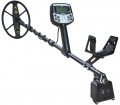Shape
The shape of the coil (frame) of the metal detector.
—
Round. The traditional form used in almost all types of ground and underwater metal detectors (see "Type"); the only exceptions are models that work according to the RF method (see "Operating principle"). When using concentric coils (see "Coil Type"), this option allows you to create a conical field, which is convenient for pinpointing the location of the find, but reduces the covered area and makes it difficult to search over a large area; models with DD coils do not have this drawback.
—
Elliptical. The shape in the form of a longitudinally elongated ellipse allows you to somewhat "stretch" the field created by the metal detector in length. This is especially true for coils of the concentric type — however, such an expansion somewhat reduces the positioning accuracy of individual finds. But in coils of the DD type, where the accuracy is by definition low, the choice between round and elliptical shape is most often not fundamental.
—
Rectangular. A specific form used in RF or PI instruments. For technical reasons, it is considered optimal for such devices, but it is practically not found in other types of metal detectors.
—
Butterfly. Another option used in DD coils along with the ellipse (see above). In fact, it consists of two elliptical windings
..., partially combined and resembling butterfly wings in shape — hence the name. This option is typical mainly for large-sized DD coils; with a large width, it is considered more optimal than an ellipse.Frequency
The characteristics of the installed coil determine the operating frequency of the metal detector. See "Detection frequency" for more details.
Dimensions (WxD)
The size of the standard coil (frame) of the metal detector. Theoretically, the larger it is, the deeper the device is able to “see” and the more space it captures in one pass, but the worse it is suitable for searching for small objects and the lower the accuracy with which it localizes them. At the same time, these characteristics depend on so many other factors that in fact, the size of the coil itself affects them very little.
Note that for coils (frames) of an elliptical shape, only one size can be indicated — along the length.
Number of detection frequencies
The number of individual operating frequencies at which the metal detector can operate. For more on the frequencies themselves, see "Detection Frequency" below; here we note that the more options (
3 frequencies and more) are provided in the design, the wider the capabilities of the metal detector, the easier it is to adjust it to the specifics of the objects being searched and the environment. However, most models have
one frequency.
Detection frequency
The operating frequency (or frequency range) of the metal detector. This is one of the most important parameters when choosing a device, because the optimal frequency for different cases will be different — depending on the size and material of the items being searched, the characteristics of the soil and other factors. Detailed recommendations on the choice of frequency for each specific situation can be found in special sources; And already on the basis of this information, it is worth choosing a specific model.
Note that the actual frequency at which the metal detector will operate also depends on the installed coil — they are usually made for a specific frequency. Therefore, to use the full capabilities of the device with the ability to adjust this parameter, you may need replaceable coils.
Max. detection depth
The greatest depth at which a metal detector is guaranteed to be able to detect a metal object. Note that this parameter is most often quite approximate, moreover, somewhat conditional. This is due to the fact that it is usually indicated for an perfect environment (low-mineralized soil, a fairly large object, the material of which optimally matches the frequency of detection of the coil, etc.), and even for such conditions it is difficult to derive an absolutely accurate value. Therefore, in fact, the detection depth is highly dependent on a number of additional factors (from soil characteristics to user skills) and can be significantly less than indicated in the characteristics. Nevertheless, the claimed depth describes the capabilities of the metal detector quite well, and it is quite possible to compare different models with each other.
Note that a large depth not only increases the cost of the device, but can also adversely affect its ability to detect small objects.
Coin detection depth
The deepest depth at which a metal detector is capable of detecting small coins and other objects of similar size. Many users buy a device with the intention of “hunting” for metal trifles, so manufacturers often indicate this parameter separately in the specifications. Due to the small size of the coins, their detection depth is usually much less than the total maximum detection depth (see above).
Number of modes
The number of pre-installed programs for searching for various materials. Their number reflects the capabilities of a particular model, allowing you to start working right off the bat.
Search modes
Regular metal detector search programs include detection of coins, all metals, jewelry and relics. In some models, this list can be expanded with "Beach" programs, custom (user) detection mode, etc.

